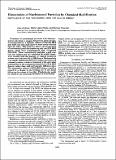Por favor, use este identificador para citar o enlazar a este item:
http://hdl.handle.net/10261/32214COMPARTIR / EXPORTAR:
 SHARE
BASE SHARE
BASE
|
|
| Visualizar otros formatos: MARC | Dublin Core | RDF | ORE | MODS | METS | DIDL | DATACITE | |

| Campo DC | Valor | Lengua/Idioma |
|---|---|---|
| dc.contributor.author | Jordano, Juan | - |
| dc.contributor.author | Nieto, M. Ángela | - |
| dc.contributor.author | Palacián, Enrique | - |
| dc.date.accessioned | 2011-02-10T10:21:10Z | - |
| dc.date.available | 2011-02-10T10:21:10Z | - |
| dc.date.issued | 1985-08-05 | - |
| dc.identifier.citation | Journal of Biological Chemistry 260(16): 9382-9384 (1985) | es_ES |
| dc.identifier.issn | 0021-9258 | - |
| dc.identifier.uri | http://hdl.handle.net/10261/32214 | - |
| dc.description | 3 páginas, 3 figuras. | es_ES |
| dc.description.abstract | Treatment of nucleosomal particles with dimethylmaleic anhydride, a reagent for protein amino groups, is accompanied by a biphasic release of histones H2A plus H2B; one H2A.H2B dimer is more easily released than the other. This behavior allows the preparation of nucleosomal particles containing only one H2A.H2B dimer, which were complemented with 125I-labeled H2A.H2B. These reconstituted particles, which contain one labeled and one unlabeled H2A.H2B dimer, were treated with the amount of reagent needed to release one of the two H2A.H2B dimers. Radioactivity was equally distributed between residual particles and released proteins, which is consistent with equivalent binding sites in the nucleosomal particle for H2A.H2B dimers, rather than with intrinsically different sites. The asymmetric release of H2A.H2B dimers would be caused by a change in the binding site of one dimer following the release of the other. This behavior might be related to the structural dynamics of nucleosomes. | es_ES |
| dc.description.sponsorship | This work was supported in part by the Fondo de Investigaciones Sanitarias and the Comisión Asesora de Investigacion Cientifica y Tecnica (Spain). The costs of publication of this article were defrayed in part by the payment of page charges. | es_ES |
| dc.language.iso | eng | es_ES |
| dc.publisher | American Society for Biochemistry and Molecular Biology | es_ES |
| dc.relation.isversionof | Publisher's version | - |
| dc.rights | openAccess | es_ES |
| dc.title | Dissociation of nucleosomal particles by chemical modification. Equivalence of the two binding sites for H2A.H2B dimers | es_ES |
| dc.type | artículo | es_ES |
| dc.description.peerreviewed | Peer reviewed | es_ES |
| dc.relation.publisherversion | http://www.jbc.org/content/260/16/9382.abstract | es_ES |
| dc.contributor.funder | Instituto de Salud Carlos III | - |
| dc.contributor.funder | Instituto Nacional de Previsión (España) | - |
| dc.relation.csic | Sí | - |
| dc.identifier.funder | http://dx.doi.org/10.13039/501100004587 | es_ES |
| dc.type.coar | http://purl.org/coar/resource_type/c_6501 | es_ES |
| item.openairetype | artículo | - |
| item.grantfulltext | open | - |
| item.cerifentitytype | Publications | - |
| item.openairecristype | http://purl.org/coar/resource_type/c_18cf | - |
| item.fulltext | With Fulltext | - |
| item.languageiso639-1 | en | - |
| Aparece en las colecciones: | (CBM) Artículos | |
Ficheros en este ítem:
| Fichero | Descripción | Tamaño | Formato | |
|---|---|---|---|---|
| nucleosomal_particles_Jordano.pdf | 1,77 MB | Adobe PDF |  Visualizar/Abrir |
CORE Recommender
Page view(s)
298
checked on 19-abr-2024
Download(s)
162
checked on 19-abr-2024
Google ScholarTM
Check
NOTA: Los ítems de Digital.CSIC están protegidos por copyright, con todos los derechos reservados, a menos que se indique lo contrario.
